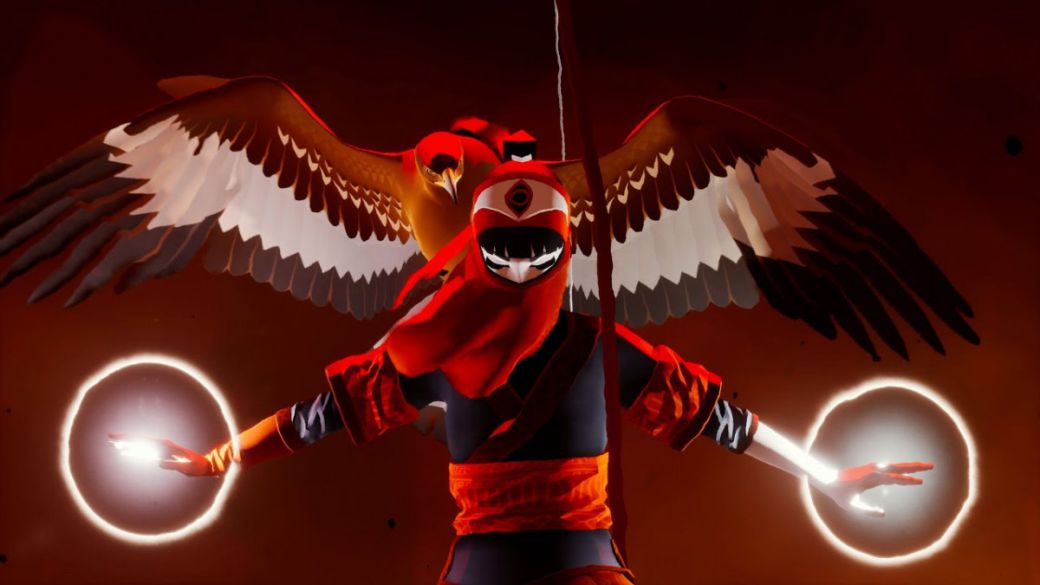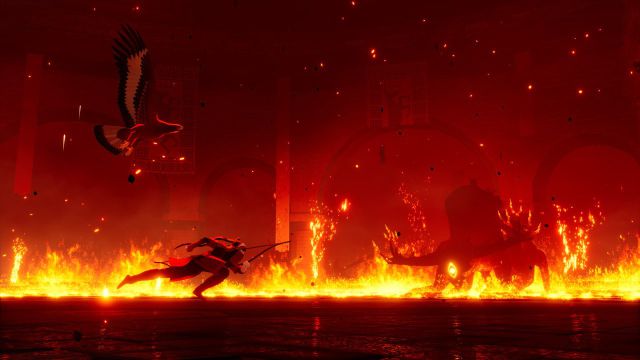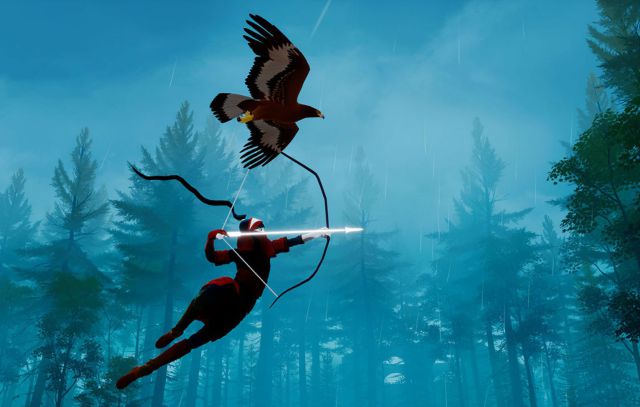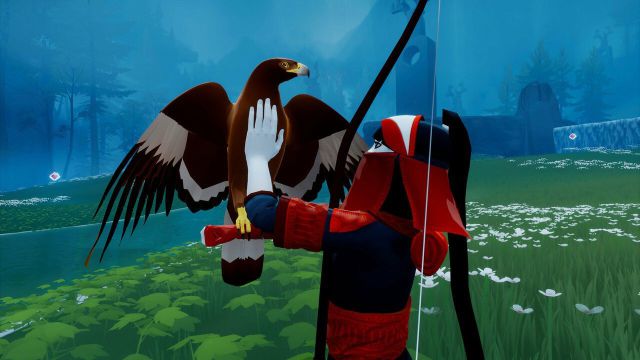
We dive into the second Giant Squid game. Elegance and good work for a job that knows how to avoid past mistakes.
The newest from Giant Squid, creators of the beautiful and contemplative ABZU, comes to iPhone / iPad, PS4, PS5 and PC. It distributes Annapurna, whose exquisite and heterogeneous catalog is nourished by stylish works full of good taste. Is The Pathless worthy of such an elitist club, or has it sneaked in covered in glamorous promises? Join us in our Reviews of the PS4 version to find all the answers.
Annapurna Seal of Quality
The Annanpurna mountainous massif, located in the Himalayas, has in its ranks the tenth highest mountain on the planet and one of the most difficult to climb, as corroborated by many misfortunes and lost souls in the attempt. The reason why Annapurna took this name may be due to the risk of its artistic proposal (and not so much because of the difficulty of its interactive products, which is almost conspicuous by its absence). Annapurna Interactive’s catalog is flawless, one of those who break shelves by accumulating prizes.
Namely, in its distribution we have both games that they sponsored from the beginning as well as others that they threw the glove to release on other platforms beyond their initial launch. We are talking about nothing less than What Remains of Edith Finch, Gorogoa, Florence, Kentucky Route Zero, Gone Home, Outer Wilds, Telling Lies, Sayonara Wild Hearts, Flower and Journey when thatgamecompany became independent from Sony (not surprisingly, Jenova Chen was Annapurna’s advisor)… The quality and commitment of Annapurna Interactive to publish “personal, emotional and original” authorial videogames is so overwhelming that you can look face to face and without blinking at its film subsidiary Annapurna Pictures, which, despite having excellent Films by Katherine Bigelow, Spike Jonze or Paul Thomas Anderson have been a bottomless pit when it comes to losing money.
The Pathless thus joins the famous list by Giant Squid, a young studio that until now had only one game on its resume: ABZU. We might think that the beautiful invoice of that underwater adventure surely opened the doors of the distributor, but there is one more detail that is very important. The founder of this small studio of just 20 people is Matt Nava, the former art director of Flower and Journey at thatgamecomapany. Major words that make all the pieces fit together in the same sensibility. It is now time to see if the recently released The Pathless meets the demanding quality standards that Annapurna is expected to have. And the answer seems more complex than a simple Yes or No. We must first go into the very bowels of the game and try to come back from there victorious. Let’s go there.
The mechanics of The Pathless, or how to dodge elongated shadows with maturity
When ABZU was launched it was not a surprise to learn who was behind the project. The reminiscences of Journey were obvious, perhaps too much. There were strong echoes of the desert Journey in the colorful underwater game, almost an obsession to emulate its devastating effect on players. We once again had composer Austin Wintory at the helm to take up the intimate and at the same time great of the thatgamecompany game, but also an urgent need to convey the same torrent of emotions.
Let’s remember. One of the most celebrated moments in Journey comes in the middle of the game, when continuous sliding is introduced down the slope of a sea of dunes. We then felt an immense pleasure in the zigzagging romp spurred on by a portentous score. Happiness and optimism fill us only to explode in us completely when the scene jumps up several rungs at once. The camera moves from the rear to the side position, the sun dyes the sand dazzling gold, and we jump for joy at the intermittent rays of light behind millenary columns. Pure beauty, pure Stendhal syndrome capable of drawing an emotional handful of tears. An instant later, after a great leap to embrace the sky that is the zenith of the sequence, we plunged into the dark catacombs of that world. The effect is devastating. The light disappears, the music is turned off, and we are thrown once again before our fragility in an unknown environment and more hostile than ever. The echo that our footsteps return to us through the blackness makes us know the enormity in which we have been locked.
That magical moment was tried to replicate in ABZU without its primal essence. A few minutes after starting to play, we enter a stream of light and color that drags us jovially among schools of fish and playful dolphins. There is no other intention at that moment than to kick. Despite its delicious packaging, the game was exposed for what it really was: a futile effort to clone the work of a genius. It was clear that Matt Nava was not Jenova Chen, and that ABZU, despite an ending that did live up to the benchmark, would never be Journey. Time has buried that uncomfortable context, which makes playing ABZU today that much more rewarding. If we have remembered that significant moment it is because The Giant Squid rescues him again, this time in The Pathless, only now it works. How did they do it? Stripping it of its greatness and assimilating it into normalcy as one of the main mechanics of the game.

Looking for the eternal slip
Quickly gliding through the vast expanses of the game is a bit strange at first. To do this we need to shoot floating icons throughout the mapping that continually fill a bar in the middle / bottom of the screen. We can focus on the direction of our career because targeting is automatic. We only have to worry about keeping our bow drawn for a second so that the shots are effective. We say that it is something strange because it is a possibility of movement that occurs to us from the first bars of the game. We have just started walking and are already gliding fast across the terrain. This results in the beginning that, if due to our lack of initial skill we deplete the strength bar, returning to simply running seems very slow.
This feeling only lasts a few minutes. As soon as we master the technique, much of the time we will move like this. And it is a pleasure, because it is easy to experiment with its possibilities, such as the fluid changes of direction or to see time slow down by a sigh when we jump with our drawn bow. We do not know at the time, but we are training for the challenge of fighting the final enemies of each section. Well, the only enemies, actually.
Before those moments we must unlock certain towers with totems that we get by solving puzzles. The game is quite kind to the player, and we are offered more puzzles than necessary in case there are any that we cross. Nor is this thought just so that the rhythm does not decline, when we purify an area of evil that overshadowed its landscapes, everything is cleared with a light that makes them new before our eyes. We will continue advancing in our adventure, but we already guessed then the pleasure that it will be to return to these beautiful places, once we have finished the game, to solve what we have pending.
But let’s get back to the bosses. Here is one of lime and another of sand, although fortunately the bad is quickly buried by the good. When darkness still reigns in a territory, the unbeatable leader of that area forces us to hide. These phases of stealth are pleasant and surprising at first, but they quickly become repetitive. The good comes later. Once the confrontation is possible, it is much more satisfactory than we had imagined. The combats have several stages that, although the first one coincides in all the bosses, the following ones have great routines that in turn are divided into several memorable moments. A pity that there are so few beings to beat, because we have thoroughly enjoyed each encounter.

The hawk and the arrow
Okay, it’s an eagle actually, but we wanted to pull off an adventure film classic for the title of this section. The fact is that this bird also has a place in the game to start from. It is not about the Assassin’s Creed saga but about Zelda Breath of the Wild. The modern Nintendo classic proves its importance in the medium despite the short period of time since its launch. It does so through its palpable influence in titles such as the aforementioned Ubisoft saga (because of how they use the enormous mapping and the possibility they offer to scale almost any surface in the latest installments) or titles that impudently trace it in various aspects such as surprising and successful Genshin Impact.
The Pathless does the same with an eagle as a parasail. And it is that we feel the same pleasant sensation as in Breath of the Wild when we grasp the legs of the bird and slowly descend from the top of a mountain to the meadow that extends at its feet. Again Giant Squid dodges the annoying feeling of blatant homage by making this mechanic his own, expanding it, making it an essential part when solving puzzles, fighting and advancing through the world. Unraveling mysteries increases the eagle’s capabilities to the point where we almost feel like we can fly freely.
There is also a sense of repetition when we must occasionally cleanse our dear ally of the impurities of the world. With the two characters in the foreground, we use the left joystick as a hand that glides smoothly over the body and wings of the animal, erasing the remains of impurity that impregnate it. It is so well implemented, the feeling it conveys is so pleasant, that in this case it doesn’t matter so much that we have to perform the action perhaps more than it should (hopefully they have enhanced this action haptically through the dual sense of PS5). When the eagle is clean, he caresses us with his head in gratitude while the protagonist closes her eyes and we guess a smile under the veil that covers her mouth. These scenes convey the emotional bond of friendship that unites them. And that leads us to the great artistic direction.

Silencing a limited budget based on wasting style
The independent origin is noted in The Pathless. There is no exhibitionism of technical muscle here, no millions of polygons spitting out glittering particles in a display of graphic power. And you don’t need it. The game is sleek, elegant, and more and more precious as we go along. As we mentioned above, once freed from the darkness, its beautiful landscapes already bathed in sunlight cry out for you to return to them once the game is over. They are huge stages that play with the extension but also with the height, being perfectly appreciable from the second the enormousness of the first.
Our protagonist is stylish and fragile in appearance. That design fits perfectly with his agility and dexterity when it comes to running and fighting. The eagle, for its part, is the most faithful representation to reality in this cartoon world. The almost total absence of icons in the hud helps to avoid them in the middle of the character’s kinetics. It is almost a ballet in which everything fits between trees and old ruins. The bosses for their part, comply without showing off. The reminiscences of Breath of the Wild or Shadow of the Colossus remain, here, in evidence before the replica. Luckily these bugs are more than redeemed in the aforementioned final battles.
Austin Wintory and the collaborative soundtrack
To conclude, it may seem unnecessary to dedicate a whole section, and not simply a mention, to the music that accompanies our adventure. Because the compositions are good, but they are not memorable except for some specific moments. The fact is that we believe that it is worth stopping here for a few moments for the detail of how it was composed.
Austin Wintory, who repeats after ABZU, requested last year through social networks the collaboration of the community at the time of reinterpreting what he was doing in Erica, the interactive film that we analyze here at the time. The proposal received the enthusiastic support of talented fans of the musician. Wintory was so delighted with the result that he contacted three of the participants, including the Spanish guitarist Enoc Benítez. All of them participated in the recording of the soundtrack of The Pathless with incredible contributions. Of course, it is an action to take into account in this enormous ocean of possibilities that is the internet.
Once the game is released, Wintory returns to the load. On Twitter he has published a video with the process that led to this collaboration. It also kicks off a new challenge asking the talented community to reinvent musical passages from The Pathless. As you may already suppose, the final stop is to join forces and creativity with those chosen to shape the next project at hand. So you know the musicians who are reading this, tune your instruments and your ideas and go on an adventure. Who knows, maybe your name will appear glittering in the credits of a future video game.
The Pathless finally falls a little short of Annapurna’s heavyweights. Something logical if we consider that some of them are undoubtedly among the best that this generation has given. But it is a remarkable game in which there is an intimate affection that only some independent games can convey. Giant Squid is also increasingly sure of its possibilities, so much so that it is capable of reinventing what it inherits from its references. If thatgamecompany, the former home of the studio’s founder, achieved enormous works starting from his own humble name written in lowercase, one can sense in this Giant Squid more and more desire to emulate with ambition what his capital letters propose.
CONCLUSION
The Pathless is a solvent adventure where Giant Squid cleverly camouflages its debit to the ideas of influential titles. He is able to give his product personality despite a certain continuing familiarity, and he does so by assimilating, expanding and even perfecting what he takes from other games. Its displacement mechanics work to form a majestic ballet of sliding, jumping and pleasant gliding from above. The fights against the bosses are first class and make up a title that is perhaps too kind to the player. And it is not too demanding in the six hours that it lasts. However, it earns many integers in the simple enjoyment of doubling that time when traveling through scenarios that seem new after being cleaned of darkness. There can be a lot to do in those beautiful now sunny landscapes, making it a title that joyously expands beyond its final showdown.
THE BEST
- The elegant artistic direction.
- How he makes what he has seen in other games his own.
- Great battles with the final bosses.
- Very replayable, since it allows us to finish it with a considerable percentage of puzzles to solve.
WORST
- That the player leaves it after the six hours it takes to reach the end.
- The repetitiveness of the stealth phases.
- Too kind to the player, which is detrimental to the duration of the game.
